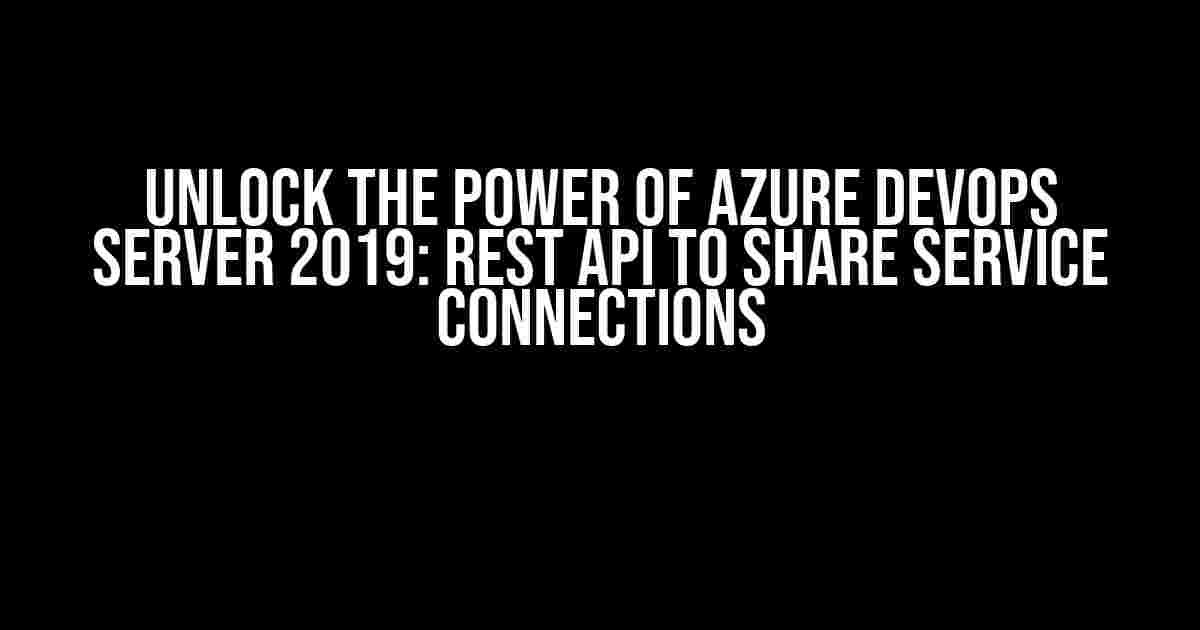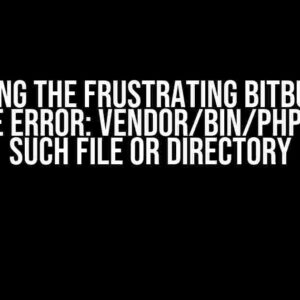Are you tired of manually sharing service connections in Azure DevOps Server 2019? Do you want to automate the process and make it more efficient? Look no further! In this article, we’ll show you how to use the REST API to share service connections in Azure DevOps Server 2019, taking your DevOps workflow to the next level.
What are Service Connections in Azure DevOps Server 2019?
Before we dive into the world of REST APIs, let’s take a step back and understand what service connections are in Azure DevOps Server 2019. Service connections are a crucial component of Azure DevOps that enable you to connect to external services, such as Azure, GitHub, or Bitbucket, and authenticate with them using credentials or tokens. With service connections, you can integrate your Azure DevOps projects with other services, enabling seamless collaboration and automation.
Why Share Service Connections?
Sharing service connections is essential in Azure DevOps Server 2019 because it allows multiple projects or teams to reuse the same connection, eliminating the need to create duplicate connections. This approach promotes consistency, reduces errors, and increases efficiency. By sharing service connections, you can:
- Streamline your workflow by reusing existing connections
- Reduce the risk of errors caused by duplicate connections
- Improve collaboration and visibility across projects and teams
- Enhance security by limiting the number of connections and credentials
Using the REST API to Share Service Connections
Now that we’ve established the importance of sharing service connections, let’s explore how to use the REST API to achieve this in Azure DevOps Server 2019. The Azure DevOps REST API provides a set of endpoints that enable you to create, update, and manage service connections programmatically.
Prerequisites
Before you start using the REST API, make sure you have the following:
- Azure DevOps Server 2019 installation
- Admin permissions on the Azure DevOps Server 2019 instance
- Familiarity with REST API concepts and tools (such as Postman or cURL)
Step 1: Authenticate with the Azure DevOps Server 2019 REST API
To interact with the Azure DevOps Server 2019 REST API, you need to authenticate using a Personal Access Token (PAT). Follow these steps to generate a PAT:
- Log in to your Azure DevOps Server 2019 instance
- Click on your profile picture or avatar in the top right corner and select
Security - Click on
Personal access tokensand thenNew Token - Select the scopes required for the REST API (e.g.,
Service Connections (Read & Write)) - Generate the token and copy it securely
Step 2: Get the Service Connection ID
To share a service connection, you need its unique ID. You can obtain the ID using the following REST API endpoint:
GET https:///_apis/serviceendpoint/endpoints/{endpointId}?api-version=6.0
Replace {endpointId} with the ID of the service connection you want to share.
Step 3: Share the Service Connection
Once you have the service connection ID, you can share it using the following REST API endpoint:
POST https:///_apis/serviceendpoint/endpoints/{endpointId}/shared?api-version=6.0
In the request body, provide the following JSON payload:
{
"shared": true
}
Replace {endpointId} with the ID of the service connection you want to share.
Step 4: Verify the Shared Service Connection
After sharing the service connection, verify that it’s accessible by checking the Azure DevOps Server 2019 UI or using the following REST API endpoint:
GET https:///_apis/serviceendpoint/endpoints/{endpointId}?api-version=6.0
In the response, look for the shared property, which should be set to true.
Conclusion
In this article, we’ve explored the power of REST APIs in Azure DevOps Server 2019, specifically how to share service connections using the REST API. By following these steps, you can automate the process of sharing service connections, promoting consistency, reducing errors, and increasing efficiency in your DevOps workflow. Remember to secure your PAT and handle errors carefully to ensure a smooth experience.
Additional Resources
For more information on Azure DevOps Server 2019 and its REST API, refer to the following resources:
- Azure DevOps Server 2019 Documentation: https://docs.microsoft.com/en-us/azure/devops/server/?view=azure-devops
- Azure DevOps REST API Reference: https://docs.microsoft.com/en-us/rest/api/azure/devops/?view=azure-devops-rest-6.0
Frequently Asked Questions
Here are some frequently asked questions related to sharing service connections using the REST API in Azure DevOps Server 2019:
| Question | Answer |
|---|---|
| What is the purpose of sharing service connections? | Sharing service connections enables multiple projects or teams to reuse the same connection, promoting consistency, reducing errors, and increasing efficiency. |
| How do I authenticate with the Azure DevOps Server 2019 REST API? | You can authenticate using a Personal Access Token (PAT) with the required scopes. |
| What is the endpoint to share a service connection? | The endpoint to share a service connection is POST https://<your-azure-devops-server>/_apis/serviceendpoint/endpoints/{endpointId}/shared?api-version=6.0. |
| How do I verify that the service connection is shared? | You can verify by checking the Azure DevOps Server 2019 UI or using the REST API endpoint GET https://<your-azure-devops-server>/_apis/serviceendpoint/endpoints/{endpointId}?api-version=6.0. |
I hope this article has been informative and helpful in your Azure DevOps Server 2019 journey. Remember to share your knowledge and experiences with others to create a more collaborative and efficient DevOps community!
Frequently Asked Questions
Got questions about sharing service connections in Azure DevOps Server 2019 using REST API? We’ve got you covered!
What is the purpose of using REST API to share service connections in Azure DevOps Server 2019?
The purpose is to allow authorized users to access and manage service connections without having to recreate them from scratch. This enables better collaboration, reduces duplication of effort, and improves overall efficiency in your development workflow.
What permissions are required to share a service connection using REST API in Azure DevOps Server 2019?
To share a service connection, you need to have the “View service endpoint” permission, which is usually granted to members of the “Service Administrators” or “Project Administrators” groups. Additionally, the user sharing the connection must have the necessary permissions to manage the service connection.
How do I use the REST API to share a service connection in Azure DevOps Server 2019?
You can use the Azure DevOps REST API to share a service connection by sending a PATCH request to the `https://dev.azure.com/{organization}/{project}/_apis/serviceendpoint/endpoints/{endpointId}?api-version=5.1` endpoint, with the required permissions and authentication. You’ll need to specify the service connection ID, the permissions to grant, and the users or groups to share with.
Can I revoke access to a shared service connection using the REST API in Azure DevOps Server 2019?
Yes, you can revoke access to a shared service connection by sending a PATCH request to the same endpoint, specifying the service connection ID and the permissions to revoke. You can also use the Azure DevOps UI to manage access to shared service connections.
What are some best practices to follow when sharing service connections using REST API in Azure DevOps Server 2019?
Some best practices include: using least privilege access, limiting sharing to only necessary users or groups, regularly reviewing and updating access permissions, and documenting shared service connections for auditing and compliance purposes.




